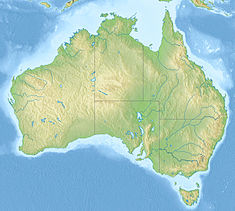
Manly is a beach-side suburb of northern Sydney, in the state of New South Wales, Australia. It is 17 kilometres (11 mi) north-east of the Sydney central business district and is currently one of the three administrative centres of the local government area of Northern Beaches Council. Manly has a long-standing reputation as a tourist destination, owing to its attractive setting on the Pacific Ocean and easy accessibility by ferry.

The Chinese Garden of Friendship is a heritage-listed 1.03-hectare (3-acre) Chinese garden at 1 Harbour Street, in the Sydney Central Business District, New South Wales, Australia. Modelled after the classic private gardens of the Ming dynasty, the garden offers an insight into Chinese heritage and culture. It was designed by Guangzhou Garden Planning & Building Design Institute, Tsang & Lee, and Edmond Bull & Corkery. It was built between 1986-1988 by Gutteridge Haskins & Davey, the Darling Harbour Authority, Imperial Gardens, Leightons, and Australian Native Landscapes. The gardens were added to the New South Wales State Heritage Register on 5 October 2018.

Manly Wharf is a heritage-listed passenger terminal wharf and recreational area located at West Esplanade and serving Manly, a Sydney suburb in the Northern Beaches Council local government area of New South Wales, Australia. Since the 1850s, it has served as the Manly embarkation and disembarkation point for the Manly to Sydney ferry service.
The Middle Harbour Syphon is a heritage-listed sewerage syphon located at Monash Crescent, Clontarf, Northern Beaches Council, New South Wales, Australia. It was designed by E. M. de Burgh, an engineer in the NSW Public Works Department and was built from 1922 to 1925 by the Department. The sewerage syphon is also known as the Middle Harbour Syphon NSOOS and The Spit Syphon. The property is owned by Sydney Water, an agency of the Government of New South Wales. The property was added to the New South Wales State Heritage Register on 15 November 2002.

Electricity Substation No. 269 is a heritage-listed electrical substation located at 36 Anglesea Street, Bondi, New South Wales, Australia. It was designed by Walter Frederick White, City Architect's Office and Municipal Council of Sydney and built in 1928 by the Municipal Council of Sydney. The property is owned by Ausgrid. It was added to the New South Wales State Heritage Register on 2 May 2008.
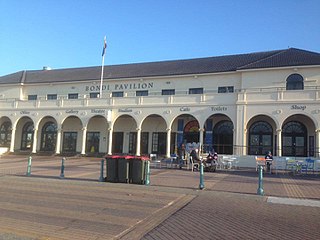
The Bondi Beach Cultural Landscape is a heritage-listed former Turkish baths, pavilion with dressing cubicles, dining rooms, sunbaking, shops and ballroom and now art gallery, pavilion, theatre and open air cinema located at Queen Elizabeth Drive, Bondi Beach, Sydney, Australia. The pavilion was designed by Robertson and Marks, with Leith C. McCredie the architect. The Bondi Surf Life Savers' Club, erected c. 1934, was designed by Ross & Rowe. The Bondi Pavilion was designed by John Howie & Sons. The cultural landscape includes the beach itself, Bondi Surf Pavilion, Bondi Park and Bondi Surf Life Saving Club and the North Bondi Surf Club. The landscape was added to the New South Wales State Heritage Register on 23 May 2008.

The Electricity Power House is a heritage-listed electrical substation located at 23 Albany Street, Crows Nest, North Sydney Council, New South Wales, Australia. It was built in 1927. It is also known as Electricity Sub-Station No. 187. The property is owned by Ausgrid, an agency of the Government of New South Wales. It was added to the New South Wales State Heritage Register on 2 April 1999.
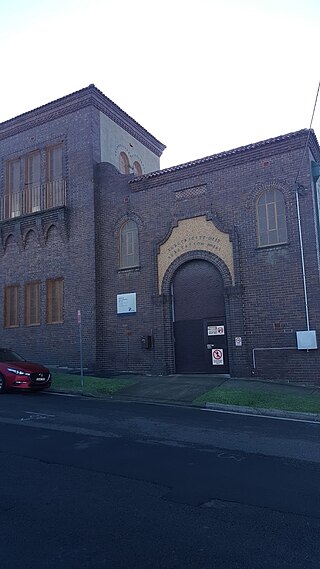
The Electricity Substation No. 341 is a heritage-listed Electrical substation at 60 Bundock Lane, Randwick, City of Randwick, New South Wales, Australia. It was built in 1929. It is also known as #341 Randwick 33 kV Zone and Canberra Street substation. The property is owned by Ausgrid, an agency of the Government of New South Wales. The substation was added to the New South Wales State Heritage Register on 2 April 1999.

The Electricity Substation No. 349 is a heritage-listed electrical substation at 2S Frances Street, Randwick, New South Wales, Australia. It was designed by Walter Frederick White, City Architect's Department and Municipal Council of Sydney and built during 1930 by J Rutherford. It is also known as #349 Princes Street substation. The property is owned by Ausgrid. It was added to the New South Wales State Heritage Register on 2 May 2008.

The Fortune of War Hotel is a heritage-listed pub located at 137 George Street, in the inner city Sydney suburb of The Rocks in the City of Sydney local government area of New South Wales, Australia. It was designed by the Tooth & Co. resident architect and built in 1922 by H. J. & H. W. Thompson. The property is owned by Property NSW, an agency of the Government of New South Wales. It was added to the New South Wales State Heritage Register on 10 May 2002.
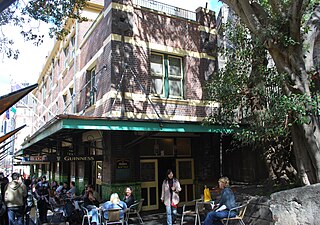
The Mercantile Hotel is a heritage-listed pub located at 25–27 George Street, in the inner city Sydney suburb of The Rocks in the City of Sydney local government area of New South Wales, Australia. It was designed by Spain & Cosh Architects and built in 1914. The property is owned by Place Management NSW, an agency of the Government of New South Wales. It was added to the New South Wales State Heritage Register on 10 May 2002.
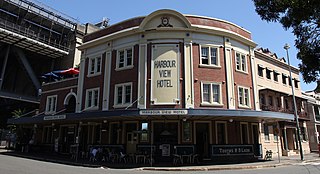
Harbour View Hotel is a heritage-listed hotel at 18 Lower Fort Street, in the inner city Sydney suburb of Millers Point in the City of Sydney local government area of New South Wales, Australia. It was designed by Prevost & Waterman and built from 1922 to 1923. It is privately owned. It was added to the New South Wales State Heritage Register on 2 April 1999.

The NSW Housing Board Building is a heritage-listed former police station and government building and now commercial offices located at 16–18 Grosvenor Street in the inner city Sydney suburb of The Rocks in the City of Sydney local government area of New South Wales, Australia. It was designed by William Henry Foggitt and built in 1921 by J. McCarthy. It is also known as NSW Housing Board Building (former) and Charlotte House. The property is owned by Property NSW, an agency of the Government of New South Wales. It was added to the New South Wales State Heritage Register on 10 May 2002.
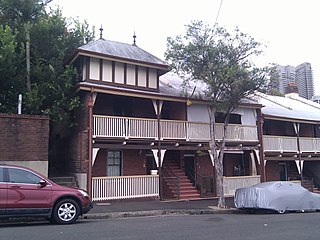
2–36 High Street, Millers Point are heritage-listed terrace houses located at 2–36 High Street, in the inner city Sydney suburb of Millers Point in the City of Sydney local government area of New South Wales, Australia. The property was added to the New South Wales State Heritage Register on 2 April 1999.

3–9 High Street, Millers Point are heritage-listed terrace houses located at 3, 5, 7, 9 High Street, in the inner city Sydney suburb of Millers Point in the City of Sydney local government area of New South Wales, Australia. The property was added to the New South Wales State Heritage Register on 2 April 1999.
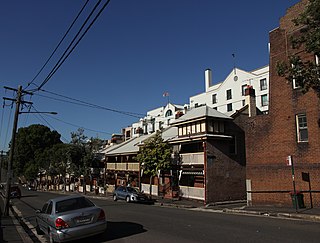
38–72 High Street, Millers Point are heritage-listed terrace houses located at 38–72 High Street, Millers Point, City of Sydney, New South Wales, Australia. The properties are privately owned. It was added to the New South Wales State Heritage Register on 2 April 1999.

74–80 High Street, Millers Point are heritage-listed terrace houses located at 74–80 High Street, Millers Point, City of Sydney, New South Wales, Australia. The property was added to the New South Wales State Heritage Register on 2 April 1999.
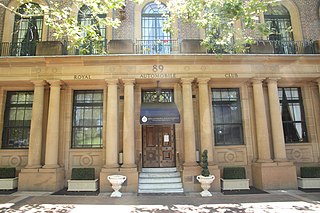
Royal Automobile Club of Australia building is a heritage-listed clubhouse located at 89–91 Macquarie Street, Sydney, City of Sydney, New South Wales, Australia. It was designed by H. E. Ross and Rowe and built from 1926 to 1928 by William Hughes and Co. It was added to the New South Wales State Heritage Register on 2 April 1999.

The Darling Harbour Carousel is a heritage-listed carousel located at the concourse under the Western Distributor at Darling Harbour in the Sydney central business district in the City of Sydney local government area, New South Wales, Australia. It is also known as The Carousel. It was added to the New South Wales State Heritage Register on 28 June 2002.

AMA House, Sydney or the Australian Medical Association House, Sydney is a heritage-listed former medical office and library and now commercial offices located at 135–137 Macquarie Street in the Sydney central business district, in the City of Sydney local government area of New South Wales, Australia. It was designed by Fowell & McConnel and built from 1929 to 1930 by Messrs Hutcherson Bros. It was formerly known as BMA House or the British Medical Association House. The property is privately owned. It was added to the New South Wales State Heritage Register on 2 April 1999.



